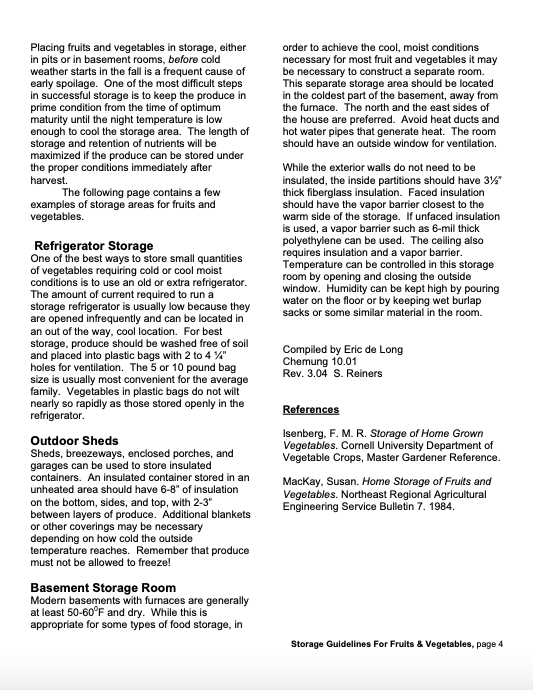How to store your farm fresh produce
Storing veggies from the store is a bit different from storing veggies from the farm because everything has been freshly harvested and expertly handled when it arrives at your doorstep. Here’s all you need to know about whether to put your tomatoes in the fridge or what!
COLD & MOIST (32 degrees, 90-95% relative humidity)
Apples, berries, cherries, grapes, pears, plums (32 degrees, 90-95% relative humidity). Apples and pears will last 2-6 months. Cherries and more delicate fruits like plums will last 1-2 weeks. Berries have 2-7 days. Grapes can last up to 6 weeks from harvest. All of these items do best with a loosely tied produce bag for long term storage.
Asparagus, broccoli, Brussels sprouts, Bok choi, cabbage, cauliflower, corn, endive, fennel, garlic scapes, green beans, leeks, peas, rhubarb, scallions (32 degrees, 90-95% relative humidity). Most veggies will last 1-3 weeks. Corn has 4-7 days. Brussels sprouts and cabbage can last up to 5 weeks. Scallions like to be put in a cup with a shallow drink of water. These veggies do best in a loosely tied produce bag for longterm storage.
Beets, carrots, celery root, parsnips, radishes, rutabaga, potatoes (32 degrees, 90-95% relative humidity). The majority have a storage life of 3-5 months. Potatoes can last up to 9 months. Carrots, too, so long as they are wintered and were pulled in the late fall after a frost. A loosely tied, roomy plastic bag is great for all of these items. If you see them starting to dry out, give a little spritz of water.
Fresh herbs (32 degrees, 90-95% relative humidity). Herbs will generally last a few days to a week in a loosely tied plastic bag. If they are starting to wilt, put them in a very shallow cup of water with a fresh snip on the stems, regularly change the water and you’ll give yourself an extra day or so.
Greens (32 degrees, 90-95% relative humidity). Most greens from the farm will last 1-3 weeks will store best in a loosely tied plastic thank you bag. Some greens are heartier than others – our spinach has been know to last up to 4 weeks.
WARM & DRY (50-60 degrees, 60-85% humidity)
Hot peppers (50 degrees, 60-65% humidity). Can last up to 6 months! Too hot on the countertops? Wrap in a towel and put in the fridge.
Pumpkins, winter squash (50-75 degrees, 50-60% relative humidity). 2-6 month storage life. Squash typically stores for longer than a pumpkin. In a cool space or in a warm crisper.
Sweet potatoes (55-60 degrees. 80-85% relative humidity). 4-6 month storage life. Keep in a cool space or a warm crisper.
COOL & MOIST (40-55 degrees, 80-95% humidity)
Tomatoes (45-70 degrees, 90-95% relative humidity). Depending on ripeness, 4 days to 3 weeks. Contrary to general knowledge, unless your tomatoes are green, tomatoes straight from the farm prefer a cooler environment than your countertop. We store them wrapped in a few dish towels in the crisper, or in a Tupper ware container lined with paper towels. It’s important not to stack your tomatoes! Bruising significantly damages shelf life.
Sweet peppers, snap peas, new potatoes, cucumbers (40-50 degrees, 90-95% relative humidity). Keep in the crisper, or a warmer fridge, sans bag or with a loosely tied plastic bag.
Melons (40-50 degrees, 80-90% relative humidity). Keep in the crisper, or a warmer fridge, sans bag! You’ve got 2-3 weeks on these.
Eggplant (45-50 degrees, 90% relative humidity). Keep in the crisper wrapped in a towel for warmth, or a warmer fridge, sans bag. Eggplant doesn’t last as long, you’ve got about a week or two from harvest.
COOL & DRY (32 degrees, 65-70% humidity)
Garlic, onions. (32 degrees, 65-70% relative humidity). Best stored in your crisper, lined with a towel. 6-7 months longevity from harvest.
Don’t have enough space or enough refrigerators to control humidity to a 5% differential? Chances are if you eat well within the expected due date, you won’t have to worry about anything like that. If you want to get extra about it, keep one of your crispers just for garlic and onions and add some paper towels you change regularly.
This nifty guide below from Cornell University is what we have pinned up on our coolers and has a lot more great tips on how to adhere to these specifications, especially if you live in a tricked out farmhouse or even a house with a basement –


